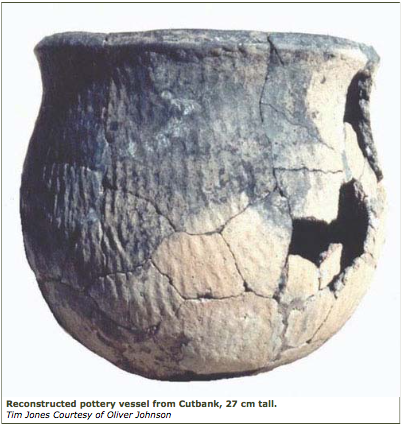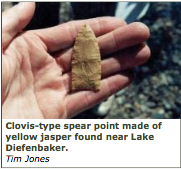

The Environment. Material culture is found in a physical context: the environment. Over thousands of years, environments change. When humans first set foot in what is now Saskatchewan, the northern half was still covered by glacial ice. The land surface closest to the ice sheet was tundra; moving south, first was boreal or northern forest, and then the area from Regina south, which was open woodland and aspen parkland. But this changed relatively quickly: over the last 8,000 or so years, the two dominant ecosystems in Saskatchewan have been the boreal forest in approximately the northern half of the province, and the plains ecosystem (grassland and parkland) in the southern half, with the border between the two moving north or south a few kilometres with climatic fluctuation. The bison was the dominant animal in the plains ecosystem. The large ice age mammals, including mammoths, horses, camels, and sabre-toothed cats, were mostly gone by the time humans arrived.
Material Cultures and Their Sequence. The prehistoric material cultures of southern Saskatchewan have varied over time, with some aspects changing more than others. Some such materials are characteristic of times and places: these artifacts then become diagnostic of those times and places. Less diagnostic, but contextually important, aspects of material cultures are features, marks left on and within the earth by human activity, such as hearths. The most distinctive diagnostic materials from southern Saskatchewan’s prehistory are stone projectile points and pottery or ceramics, the latter extending back to a maximum of about 2,000 years in time and the former back to the first humans. Based on such materials, archaeologists have identified three cultural periods in North America, all of which apply to southern Saskatchewan, predictably named the “Early” (12,000-8,000 years ago), “Middle” (8,000-2,200 years ago), and “Late” (2,200 years ago to A.D. 1690) periods. The first two of these are identifiable mostly by projectile points; the third is identified both by projectile points and ceramics in association with certain other tools that make up distinctive assemblages.
The oldest scientifically dated site in Saskatchewan is at Ponteix, where a hearth and associated stone tool-making debris dates to 10,000 years ago, in the middle of the Early period. The earliest peoples hunted mostly bison by various methods, including still-hunting, impounding or surrounding; they also took a wide variety of smaller mammals as well as fish. Vegetable materials were important resources too, but these have not been well preserved. Spears were used to kill animals, so that the projectile points characteristic of this cultural period are spear points (see accompanying photo). In fact, the second-oldest radiocarbon-dated archaeological site, Heron Eden, contains 9,000-year-old spear points in direct association with the bones of about three dozen bison, of a variety larger than the modern one. Over the Saskatchewan prairies a number of spear points identical to types excavated and dated in sites elsewhere in North America, especially in the American Plains, have been found (Clovis, Folsom, Eden, Hell Gap, etc.); unfortunately, most are surface finds, and therefore not datable. However, the fact that many of these finds are made of Swan River Chert, a chippable stone type found primarily in eastern Saskatchewan and western Manitoba, suggests that local people were present at this early period. This interpretation is supported by the discovery of a spear point made of Swan River Chert at the St. Louis Site in 2002, dating to about 7,800 years ago. Over 4,500 years or so of occasional human occupancy, the environment of the St. Louis site changed from forest to parkland.
The Middle period is marked by an increase in specialized artifact types, such as pestles and grinding stones, associated with use of vegetable resources, and by a reduction in projectile point size as well as style changes. Notched dart points become common, the notches likely being used for attaching to short spears or darts that were launched with throwing sticks or atlatls. Bison remained the predominant resource, as during the Early period.
The Late period is marked by three important shifts identifiable in the archaeological record: a switch to much smaller notched stone projectile points, arrowheads, launched with bows; the introduction and rapid dispersal of use of ceramics to carry and heat food and water (see accompanying photo); and a marked increase in use of mass bison kill techniques (drives and jumps) as a means of procuring this all-important animal.
The archaeological record in southern Saskatchewan, then, shows both a series of identifiable changes in technology and lifestyle, yet a continuity in the nature of the primary resource, bison. The record also shows an identifiable increase in efficiency of resource extraction and preparation practices, along with an increase in the use of vegetable materials.
The lifeways of prehistoric peoples in southern Saskatchewan reflect the hunting-gathering lifestyle, with heavy emphasis on the bison resource. Bison are non-territorial bovines capable of frequent movement, including regular migrations. Some populations were probably resident in relatively small home ranges the year round, but the majority—as much as 90% or more—migrated onto the grasslands for the summers and into lightly wooded areas for the winters. Environments favoured by both resident herds and winter migrants tended to be lightly wooded hills and stream valleys on the grasslands, while in the parkland they were distributed more widely. In the open grasslands, these places favoured by bison also contain human habitation site concentrations, usually near water, with an inferred linkage to resident bison herds and presence of winter migrants.
Population and Ethnicity. How many people may there have been in the plains ecosystem in Saskatchewan at any one time? Based on the use of bison as the dominant resource, and on historic records, an educated guess would be 10,000–15,000 persons during most years. What was the ethnicity of the prehistoric people occupying what is now southern Saskatchewan? There is sound evidence for projecting ethnicity back in time a short way via recognizable artifacts, especially pottery, so that a Cree presence in the northern edge, Blackfoot and Atsina in the southwest, and Assiniboine in the south-centre and southeast can be inferred with a high level of likelihood. Beyond that, however, implying ethnicity to material cultures becomes very difficult largely because a generic stone toolkit, one well-adapted to the environment of the Plains region, was developed early and persisted because of its suitability. The ethnicity of the most ancient cultures is a matter of guesswork, and hence is avoided by archaeologists.
The prehistory of southern Saskatchewan is not unique in North America, but its archaeologists have contributed substantially to the development of material culture histories within the plains and boreal forest environmental contexts. Several projectile point and pottery types (Oxbow, Besant, Avonlea) have been identified and named here first. One of the earliest scientific excavations in North America that analysed geo-environmental information along with archaeological information was done at the Mortlach Site in 1954.
Concentrations of sites related to hilly and stream valley wooded environments and to related resource distribution have been identified in Saskatchewan as well, contributing to theoretical explanations of prehistoric human settlement and movement patterns. These and other works have contributed to the regional culture history of the continent.
Henry Epp, Tim E.H. Jones

